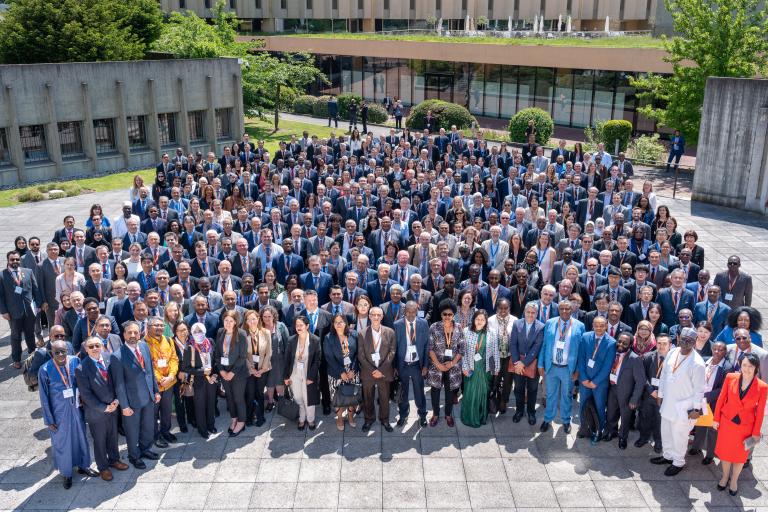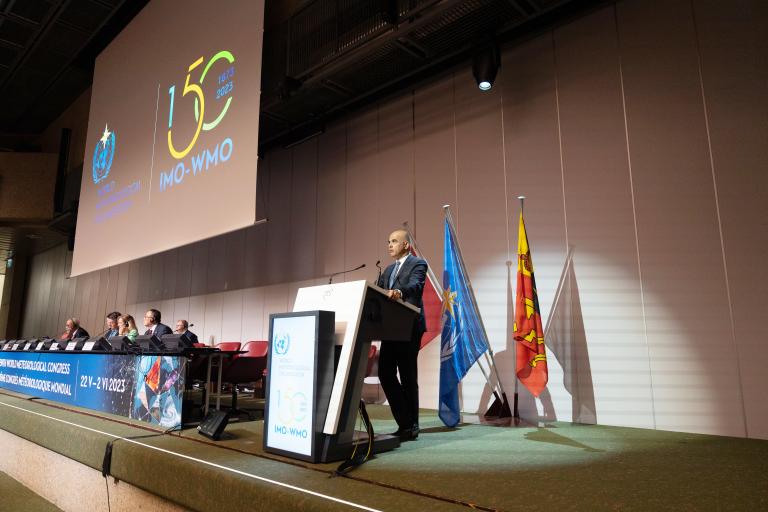World Meteorological Congress opens quadrennial session
The World Meteorological Congress opened its quadrennial session with a high-level dialogue on the international campaign to ensure that everyone in the world is protected by early warning systems by the end of 2027.

The World Meteorological Congress opened its quadrennial session with a high-level dialogue on the international campaign to ensure that everyone in the world is protected by early warning systems by the end of 2027.
“We need a strong World Meteorological Organization. We need meteorological services at the national level which also must be strong. They are the spine of WMO. We need them to provide reliable information on climate and to warn populations of natural hazards,” said Swiss President Alain Berset in an opening address.
The Early Warnings for All initiative is one of the top strategic priorities at Congress., WMO’s top decision making body. The 193-Member body will also consider a raft of other resolutions to improve service delivery, strengthen observations, boost targeted research and capacity development in an era of rapidly growing needs because of climate change and more extreme weather.
This year marks the 150th anniversary of WMO’s predecessor, the International Meteorological Organization.
“The need for WMO expertise is clearly growing and that is very visible worldwide,” said WMO Secretary-General Prof. Petteri Taalas.
Death toll falls, economic losses rise
Extreme weather, climate and water-related events caused 11 778 reported disasters between 1970 and 2021, with just over 2 million deaths and US$ 4.3 trillion in economic losses, according to new updated figures released for Congress.
Economic losses have soared. But improved early warnings and coordinated disaster management has slashed the human casualty toll over the past half a century. Over 90% of reported deaths worldwide occurred in developing countries, which also suffer a disproportionately high cost in relation to the size of their economies.
Early Warning Systems are a proven, effective, and feasible climate adaptation measure, that save lives and provide at least a tenfold return on investment. And yet, the recent United Nations Office for Disaster Risk Reduction (UNDRR) and WMO Global Status of Early Warning Systems: Target G report, highlighted that only half of countries have early warning systems in place with coverage especially low in Small Island Developing States (SIDS), Least Developed Countries (LDCs) and in Africa.
“Providing Early Warnings for All is long overdue. It is a once-in-a-generation possibility to make a difference to the lives of the most vulnerable. Let us succeed,” said Assistant Secretary-General for Climate Action, Selwin Hart.

Accelerate implementation
The high-level event sought to raise awareness among WMO Members and align efforts to accelerate the in-country implementation of Early Warnings for All, as well as scale up financial support. Heads of UN agencies, development partners, ministers from target countries and donors were united in their support for the initiative.
WMO and the United Nations Office for Disaster Risk Reduction (UNDRR) are spearheading the Early Warnings for All initiative, along with the International Telecommunication Union (ITU) and the International Federation of Red Cross and Red Crescent Societies (IFRC).
The months ahead will see stepped up coordinated action, initially in 30 particularly at-risk countries, including Small Island Developing States and Least Developed Countries. Additional countries are expected to be added as this vital work with partners gathers pace, scale and resourcing.
Early Warnings for All is a great opportunity and challenge for us. It’s like a mission to moon. Lets make this mission to moon a successful one,” said Prof. Taalas. “It’s not going to be a hundred meter sprint. It’s going to be a marathon and it’s important that you are committed to the success of this initiative,” he said.
“The success or failure of this initiative will depend on the strength of partnerships that are formed,” said Mami Mizutori, Special Representative of the Secretary-General for Disaster Risk Reduction and Head of UNDRR.
Doreen Bogdan-Martin, ITU Secretary-General, said the ITU focus is on last mile connectivity to ensure that warnings reach those at risk in time for action. Three out of four people own a mobile phone, and these will be key in ensuring alerts reach people. The Common Alerting Protocol ensures that all alerts are consistent and understandable.
IFRC Secretary-General Jagan Chapagain said an estimated 200 million people per year will need international humanitarian assistance because of weather and climate related disasters. Community level action will be vital to meet this challenge, he said.
Ministerial commitment
Ministers from Curacao, Ethiopia, Mozambique, Madagascar and Niger all stressed the vital importance of improved observations and early warnings in saving lives.
For instance, Mozambique has been mobilizing funds to strengthen its meteorological network in line with the country’s initiative to have one weather station per district. A new radar will be installed by 2027 and there is a new unit for flood and drought management to predict and map hydrological risks.
The investments have paid off. Cyclone Idai in 2019 caused 630 deaths and 3 billion dollars in economic losses. Cyclone Freddy in 2023 – one of the longest-lasting tropical cyclones on record – killed less than 100 people and 176 million dollars in losses, said Mozambique’s transport and communications minister, Mateus Magala.
The donor community voiced commitments to key initiatives supporting Early Warnings For All – including the Climate Risk and Early Warning Systems initiative (CREWS) and Systematic Observations Financing Facility (SOFF) in order to build resilience and address the climate crisis.
Build resilience
Developed countries are committed to helping developing countries build resilience and address the climate crisis.
“We will continue to invest in climate observations and develop tools and products so that all communities at home and abroad have access to effective early warning products,” said NOAA administrator Richard Spinrad.
The Green Climate Fund, which has invested 12 billion US dollars into a portfolio of 216 projects, seeks to target half of our adaptation investment towards Least Developed Countries, SIDS, and African States.
For CREWS, it has already invested US$ 650 million. An additional eight early warning projects are targeting GCF Board meetings during 2023. These new projects address early warning priorities across 24 countries and would receive over US$ 203 million.
To scale up finance it is essential that the Early Warnings for All initiative takes advantage of the widest range of funders and innovative financial instruments to support sustainable investments and to enhance the role of the private sector, said the Green Climate Fund’s Henry Gonzalez.
Early Warnings for All will be one of the key intiatives presented at COP28 in the United Arab Emirates, UAE ambassador said.
Congress photos are available on Flickr.

